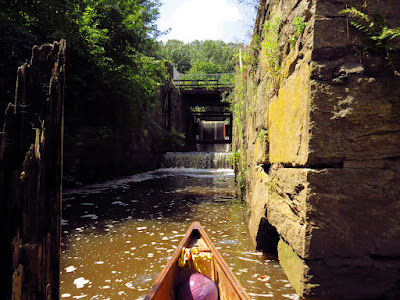My "let's go canoeing" pitch was something like seven years ago. The two of us would lose touch, run into each other, lose touch again, and so forth. But, we get along so well that we always picked up without any hint of the time that had passed. We're both artists, so we always have something meaty to say to each other.
Finally, "A" goes canoeing. We meet at my house. yesterday's forecast of showers and possible thunderstorms has changed to just showers. The tide will be very high about a quarter after eleven. I prepped the portage cart in the morning, so when A gets here, we are ready to go...after coffee and a long chat.
Earlier I asked A whether she preferred seeing birds, or beaver. Birds it was.
We portage the 250 yards to Long Island Sound. Only the last fifty of that is on my shoulders, but it is down 30 feet of stairs to the bottom of the seawall. We take the portage cart with. The wind shifted to be out of the south, and if it gets much stronger, landing here is less than fun. I tell A about my first landing in wind here and how I had to jump out in waist deep water and keep the canoe from filling and getting pushed onto the boulders. A canoe full of water has a funny way of punching holes in itself when that happens. If we have to, there are sand beaches within portage cart distance that we can divert to.
We talk our way up the shore, passing Point Rosa and whatever the next point might be called. There, I point out the low bridge over the mouth of the Oyster River. We duck low and ride the flood current into the small river. It soon opens up into a small salt marsh. We spot a Green Heron and an Osprey. There's quite a few Snowy Egrets in the short spartina, a pair of Canada Geese, and a few Great Egrets. We flush a Yellow Crowned Night Heron and two Black Crowned Night Herons. It is a meandering 3/4 of a mile up to the end of canoeable water, and there's always a few birds to look at... a small unidentified Hawk, a couple Mallards, a Kingfisher or two. We count near a dozen Great Blue Herons. The little salt marsh is holding about as many birds as one might expect. A is having a good time and comments about getting to see these birds from below and from the water for a first time.
On the way out I take advantage of the tight meanders to teach A the stationary draw stroke - a non moving paddle stroke that a bow paddler can use to pull the canoe around a corner while the stern paddler keeps power stroking. It's very efficient and a fun stroke for people to learn.
The tide is near slack when we head out into the sound. It's a good paddle back, into the wind with some chop and waves, but nothing to worry about. And with that, we're back to the seawall. Just carry the gear up to the street level and walk back.
Trip 2 is being scheduled.








































